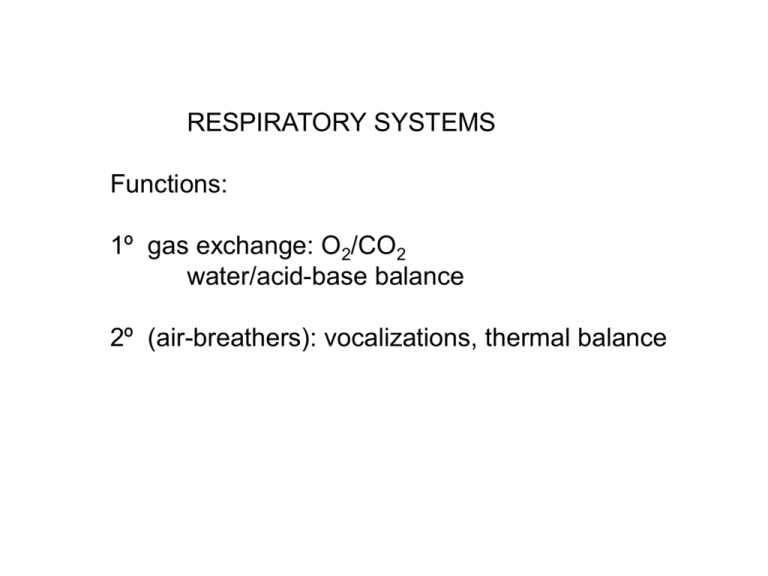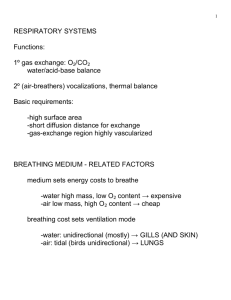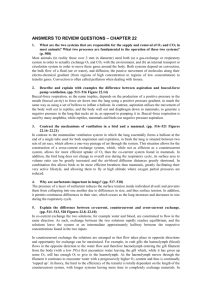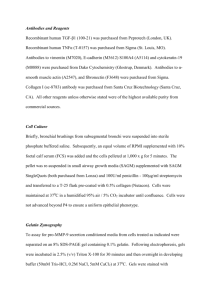RESPIRATORY SYSTEMS Functions: 1º gas exchange: O /CO water
advertisement

RESPIRATORY SYSTEMS Functions: 1º gas exchange: O2/CO2 water/acid-base balance 2º (air-breathers): vocalizations, thermal balance Basic requirements: high surface area short diffusion distance for exchange gas-exchange region highly vascularized RESPIRATORY MEDIUM: WATER OR AIR? AQUATIC TO TERRESTRIAL TRANSITION IMPOSES FUNCTIONAL CHALLENGES unidirectional Kardong f 11-42 unidirectional ventilation tidal ventilation BREATHING MEDIUM - RELATED FACTORS medium sets energy costs to breathe -water high mass, low O2 content→expensive -air low mass, high O2 content→cheap breathing cost sets ventilation mode: -water: unidirectional (mostly)→GILLS (and SKIN) -air: tidal (birds unidirectional)→LUNGS VENTILATORY ORGANS - OLD OR NEW? What are basic requirements for gas exchange? -high surface area -short diffusion distance for exchange -gas exchange surface highly vascularized Adapt what already exists? -skin advantages: next to medium, vascularized, thin disadvantages: protection function in conflict, SA low -gut advantages: access to medium (pharyngeal region, vascularized, SA can be increased New structures: based on gut -extend portion of pharynx wall into medium → GILLS -develop internal blind sac from pharynx wall → LUNGS RESPIRATORY MEDIUM: WATER OR AIR? -correlated with circulation AQUATIC - BREATHE WATER SERIAL CIRCULATION Kardong f 12-6 TERRESTRIAL -BREATHE AIR PARALLEL CIRCULATION GILL VENTILATION IN VERTEBRATES -fish -amphibians: all larval, some adults - Necturus RESPIRATION IN FISH - GILLS -breathing medium: water - dense, low O2 content -high metabolic cost to breathe -unidirectional flow - most efficient -gas exchange membrane extended into breathing medium GILL BAR IN DOGFISH (CVH65) filament with 2º lamellae cartilagenous gill bar water flow CHONDROCYTES IN GILL ARCH CARTILAGENOUS ROD (CVH184) LAMELLAE ON BOTH SIDES OF GILL FILAMENT (CVH65) filament 2º lamellae on filament HISTOLOGY OF GILL LAMELLAE 2º lamellae attached to filaments cell types: epithelial cells endothelial cells = pillar cells chloride cells (ionophores) mucus cells 2º LAMELLAE (CVH134) epithelial cells pillar cells CVH134 CHLORIDE CELLS AT BASE OF 2º LAMELLAE (CVH134) CVH134 mucous cells CVH147 filament blood vessels afferent/efferent GILL POUCHES IN LAMPREY HEAD (HORIZONTAL SECTION, CVH99) branchiopore filaments lining pouch pharynx gill bar CVH99 pumping muscle fibres run dorso-ventral gill pouch cartilagenous gill bar dorsoventral muscle gill bar CVH99 LUNG VENTILATION IN VERTEBRATES ADVANTAGES OF AIR: cheap cost to breathe: high 02 content, low mass PROBLEM: can't extend gas exchange membrane into medium -still need aqueous layer on membrane surface gases dissolve in aqueous layer moisture loss damages membrane TRENDS IN AIR-BREATHING: -internalize exchange organ: develop blind sac from gut ↑ -decrease blood-air barrier thickness: diffusion distance ↓ -increase internal surface area for exchange: septation AMPHIBIAN RESPIRATION ALL MODES GILLS: ALL LARVAL AND SOME ADULT FORMS SKIN: ALL AQUATIC AND MOST SEMI-AQUATIC FORMS LUNGS: SEMI-AQUATIC AND TERRESTRIAL FORMS LUNGS: TIDAL VENTILATION: POSITIVE-PRESSURE SYSTEM -BUCCAL PUMP - JAW MUSCLES (NO RIBS) STRUCTURE: LUNG SEPTATION MINIMAL TRACHEA, BRONCHI SHORT CILIATED EPITHELIUM, GOBLET CELLS SEPTAL WALLS THICK BLOOD-AIR BARRIER THICK CUTANEOUS RESPIRATION IN FROG (CVH32) capillary in epidermis CVH20 SEPTATION IN FROG LUNG trachea 1º bronchus septae SEPTUM IN FROG LUNG (CVH20) GX = gas exchange capillaries at surface GX smooth muscle GX GX CVH20 capillary epithelial cell capillary epithelial cell TOAD LUNG (CVH167) - SEPTATION > FROG LUNG PLEURA AND SEPTAE CONTAIN ELASTIN (CVH167) septae pleura SEPTAL WALL IN GAS EXCHANGE REGION (CVH167) smooth muscle and elastin capillaries epithelial cells with flanges SEPTAL WALL BETWEEN GAS EXCHANGE REGIONS (CVH167) -fewer capillaries -connective tissue in wall (elastin) REPTILIAN RESPIRATION RIBS APPEAR → NEGATIVE PRESSURE VENTILATION LUNGS PAIRED (snakes, lizards may have one lung reduced or absent) TRACHEA, 1º BRONCHI cartilage reinforced, ciliated with goblet cells SEPTATION MORE COMPLEX FAVEOLI - major and minor subdivisions -gas exchange in septal walls TURTLE TRACHEA - SIMILAR TO MAMMALIAN (CVH97) CVH97 respiratory epithelium hyaline cartilage RESPIRATORY EPITHELIUM IN TURTLE TRACHEA (CVH27) PSEUDOSTRATIFIED, CILIATED COLUMNAR EPITHELIUM WITH GOBLET CELLS TURTLE LUNG (CVH88) intra-abdominal muscle faveoli intrapulmonary bronchus EPITHELIUM: CONDUCTING TO GAS EXCHANGE TRANSITION (CVH88) FAVEOLUS - gas exchange BRONCHUS - conducting portion - simple -respiratory epithelium squamous epithelium RESPIRATORY EPITHELIUM (CVH88) GAS EXCHANGE REGION - FAVEOLUS * * (CVH88) GAS EXCHANGE REGION IN SUBFAVEOLUS (CVH88) capillaries SEPTUM IN FROG LUNG (CVH20) *gas exchange capillaries at surface * smooth muscle * * BIRD LUNG HIGH EFFICIENCY - supports flight metabolic requirements UNIDIRECTIONAL VENTILATION cross-current gas exchange between blood and air capillaries CROSS SECTION OF PARABRONCHUS (PB) WITH INFUNDIBULI (IN) (CVH109) IN PB CVH110 CVH109 air capillaries IN PB AIR CAPILLARIES IN GAS EXCHANGE REGION (CVH109) RESPIRATORY SYSTEMS Basic requirements: high surface area short medium-blood diffusion distance exchange surface highly vascularized SEAL LUNG (CVH186) HUMAN LUNG (HUM59)









